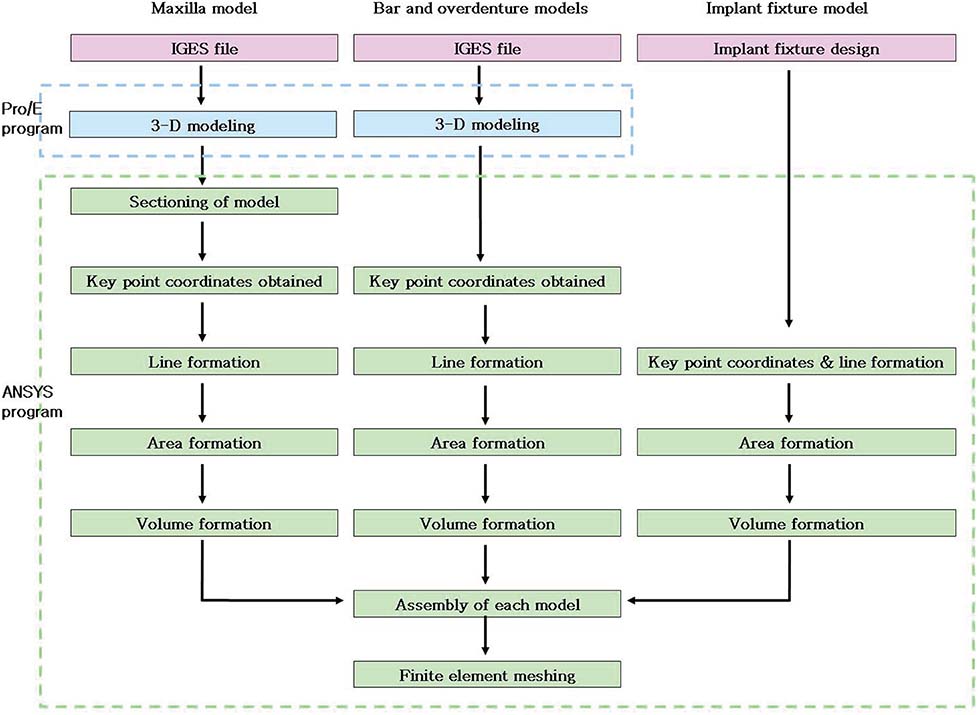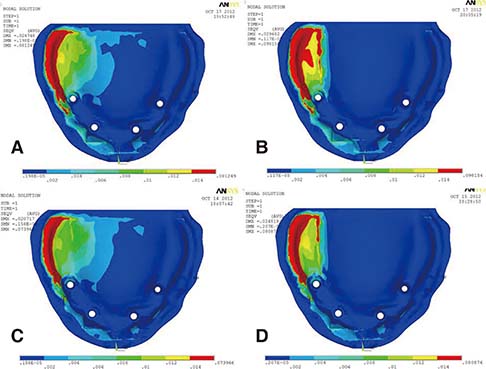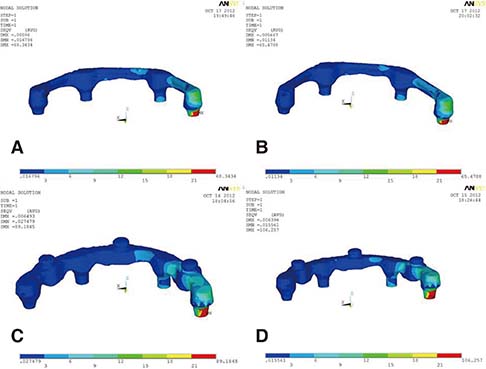J Adv Prosthodont.
2016 Apr;8(2):85-93. 10.4047/jap.2016.8.2.85.
Finite element analysis on stress distribution of maxillary implant-retained overdentures depending on the Bar attachment design and palatal coverage
- Affiliations
-
- 1Department of Prosthodontics, Wonkwang University Sanbon Dental Hospital and Institute of Wonkwang Dental Research, Iksan, Republic of Korea. simple96@naver.com
- 2Department of Conservative Dentistry, Wonkwang University, Iksan, Republic of Korea.
- KMID: 2176641
- DOI: http://doi.org/10.4047/jap.2016.8.2.85
Abstract
- PURPOSE
The purpose of this study was to determine the effect of anchorage systems and palatal coverage of denture base on load transfer in maxillary implant-retained overdenture.
MATERIALS AND METHODS
Maxillary implant-retained overdentures with 4 implants placed in the anterior region of edentulous maxilla were converted into a 3-D numerical model, and stress distribution patterns in implant supporting bone in the case of unilateral vertical loading on maxillary right first molar were compared with each other depending on various types of anchorage system and palatal coverage extent of denture base using three-dimensional finite element analysis.
RESULTS
In all experimental models, the highest stress was concentrated on the most distal implant and implant supporting bone on loaded side. The stress at the most distal implant-supporting bone was concentrated on the cortical bone. In all anchorage system without palatal coverage of denture base, higher stresses were concentrated on the most distal implant and implant supporting bone on loaded side.
CONCLUSION
It could be suggested that when making maxillary implant retained overdenture, using Hader bar instead of milled bar and full palatal coverage rather than partial palatal coverage are more beneficial in distributing the stress that is applied on implant supporting bone.
MeSH Terms
Figure
Reference
-
1. Brånemark PI, Hansson BO, Adell R, Breine U, Lindström J, Hallén O, Ohman A. Osseointegrated implants in the treatment of the edentulous jaw. Experience from a 10-year period. Scand J Plast Reconstr Surg Suppl. 1977; 16:1–132.2. Batenburg RH, Meijer HJ, Raghoebar GM, Vissink A. Treatment concept for mandibular overdentures supported by endosseous implants: a literature review. Int J Oral Maxillofac Implants. 1998; 13:539–545.3. Engquist B, Bergendal T, Kallus T, Linden U. A retrospective multicenter evaluation of osseointegrated implants supporting overdentures. Int J Oral Maxillofac Implants. 1988; 3:129–134.4. Smedberg JI, Lothigius E, Bodin I, Frykholm A, Nilner K. A clinical and radiological two-year follow-up study of maxillary overdentures on osseointegrated implants. Clin Oral Implants Res. 1993; 4:39–46.5. Jemt T, Book K, Lindén B, Urde G. Failures and complications in 92 consecutively inserted overdentures supported by Brnemark implants in severely resorbed edentulous maxillae: a study from prosthetic treatment to first annual check-up. Int J Oral Maxillofac Implants. 1992; 7:162–167.6. Hutton JE, Heath MR, Chai JY, Harnett J, Jemt T, Johns RB, McKenna S, McNamara DC, van Steenberghe D, Taylor R, et al. Factors related to success and failure rates at 3-year follow-up in a multicenter study of overdentures supported by Bnemark implants. Int J Oral Maxillofac Implants. 1995; 10:33–42.7. Bergendal T, Engquist B. Implant-supported overdentures: a longitudinal prospective study. Int J Oral Maxillofac Implants. 1998; 13:253–262.8. Mericske-Stern RD, Taylor TD, Belser U. Management of the edentulous patient. Clin Oral Implants Res. 2000; 11:108–125. Suppl 1.9. Palmqvist S, Sondell K, Swartz B. Implant-supported maxillary overdentures: outcome in planned and emergency cases. Int J Oral Maxillofac Implants. 1994; 9:184–190.10. Je HJ, Jeong YC, Jeong CM, Lim JS, Hwang JS. Effect of anchorage systems and palatal coverage of denture base on load transfer with maxillary implant-supported overdenture : A three-dimensional photoelastic stress analysis. J Korean Acad Prosthodont. 2004; 42:397–411.11. Zitzmann NU, Marinello CP. Treatment plan for restoring the edentulous maxilla with implant-supported restorations: removable overdenture versus fixed partial denture design. J Prosthet Dent. 1999; 82:188–196.12. Son CY, Jeong CM, Jeon YC, Lim JS, Jeong HC. Comparative studies of retentive forces in maxillary overdenture bar attachments. J Korean Acad Prosthodont. 2005; 43:650–661.13. Moeller MS, Duff RE, Razzoog ME. Rehabilitation of malpositioned implants with a CAD/CAM milled implant overdenture: a clinical report. J Prosthet Dent. 2011; 105:143–146.14. Spyropoulou PE, Razzoog ME, Duff RE, Chronaios D, Saglik B, Tarrazzi DE. Maxillary implant-supported bar overdenture and mandibular implant-retained fixed denture using CAD/CAM technology and 3-D design software: a clinical report. J Prosthet Dent. 2011; 105:356–362.15. Oh SC, Han JS, Kim MJ. Implant supported overdenture using milled titanium bar with Locator attachment on fully edentulous maxillae : A case report. J Dent Rehabil Appl Sci. 2011; 27:223–231.16. Ha HS, Kim CW, Lim YJ, Kim MJ. Finite element stress analysis of maxillary two implants-retained overdenture according go position of implant fixtures. J Korean Acad Prosthodont. 2008; 46:193–200.17. Kydd WL, Daly CH, Wheeler JB 3rd. The thickness measurement of masticatory mucosa in vivo. Int Dent J. 1971; 21:430–441.18. Barão VA, Assunção WG, Tabata LF, Delben JA, Gomes EA, de Sousa EA, Rocha EP. Finite element analysis to compare complete denture and implant-retained overdentures with different attachment systems. J Craniofac Surg. 2009; 20:1066–1071.19. Tokuhisa M, Matsushita Y, Koyano K. In vitro study of a mandibular implant overdenture retained with ball, magnet, or bar attachments: comparison of load transfer and denture stability. Int J Prosthodont. 2003; 16:128–134.20. Federick DR, Caputo AA. Effects of overdenture retention designs and implant orientations on load transfer characteristics. J Prosthet Dent. 1996; 76:624–632.21. Chun HJ, Park DN, Han CH, Heo SJ, Heo MS, Koak JY. Stress distributions in maxillary bone surrounding overdenture implants with different overdenture attachments. J Oral Rehabil. 2005; 32:193–205.22. Barão VA, Assunção WG, Tabata LF, de Sousa EA, Rocha EP. Effect of different mucosa thickness and resiliency on stress distribution of implant-retained overdentures-2D FEA. Comput Methods Programs Biomed. 2008; 92:213–223.23. Fanuscu MI, Caputo AA. Influence of attachment systems on load transfer of an implant-assisted maxillary overdenture. J Prosthodont. 2004; 13:214–220.24. Hoshaw SJ, Brubski JB, Cochran GV. Mechanical loading of Branemark implant affects interfacial bone resorption and remodeling. Int J Oral Maxillofac Implants. 1994; 9:345–360.25. Jemt T, Book K, Karlsson S. Occlusal force and mandibular movements in patients with removable overdentures and fixed prostheses supported by implants in the maxilla. Int J Oral Maxillofac Implants. 1993; 8:301–308.26. Mericske-Stern R, Venetz E, Fahrländer F, Bürgin W. In vivo force measurements on maxillary implants supporting a fixed prosthesis or an overdenture: a pilot study. J Prosthet Dent. 2000; 84:535–547.27. Siegele D, Soltesz U. Numerical investigations of the influence of implant shape on stress distribution in the jaw bone. Int J Oral Maxillofac Implants. 1989; 4:333–340.28. Skalak R. Biomechanical considerations in osseointegrated prostheses. J Prosthet Dent. 1983; 49:843–848.29. Sertgöz A. Finite element analysis study of the effect of superstructure material on stress distribution in an implant-supported fixed prosthesis. Int J Prosthodont. 1997; 10:19–27.30. Rieger MR, Adams WK, Kinzel GL. A finite element survey of eleven endosseous implants. J Prosthet Dent. 1990; 63:457–465.31. Clelland NL, Ismail YH, Zaki HS, Pipko D. Threedimensional finite element stress analysis in and around the Screw-Vent implant. Int J Oral Maxillofac Implants. 1991; 6:391–398.32. Borchers L, Reichart P. Three-dimensional stress distribution around a dental implant at different stages of interface development. J Dent Res. 1983; 62:155–159.33. Kim DW, Kim YS. A study on the osseointegrated prosthesis using three dimensional finite element method. J Korean Acad Prosthodont. 1991; 29:167–212.34. Lee DO, Chung CH, Cho KZ. A study on the three dimensional finite element analysis of the stresses according to the curvature of arch and placement of implants. J Korean Acad Prosthodont. 1995; 33:98–129.35. White SN, Caputo AA, Anderkvist T. Effect of cantilever length on stress transfer by implant-supported prostheses. J Prosthet Dent. 1994; 71:493–499.36. Rangert B, Jemt T, Jörneus L. Forces and moments on Branemark implants. Int J Oral Maxillofac Implants. 1989; 4:241–247.37. Engleman M. Clinical decision making and treatment planning in osseointegration. Chicago: Quintessence;1996. p. 187–192.38. Lewis S, Sharma A, Nishimura R. Treatment of edentulous maxillae with osseointegrated implants. J Prosthet Dent. 1992; 68:503–508.39. Ochiai KT, Williams BH, Hojo S, Nishimura R, Caputo AA. Photoelastic analysis of the effect of palatal support on various implant-supported overdenture designs. J Prosthet Dent. 2004; 91:421–427.40. Sakaguchi RL, Borgersen SE. Nonlinear contact analysis of preload in dental implant screws. Int J Oral Maxillofac Implants. 1995; 10:295–302.
- Full Text Links
- Actions
-
Cited
- CITED
-
- Close
- Share
- Similar articles
-
- Effect of attachments and palatal coverage of maxillary implant overdenture on stress distribution: a finite element analysis
- Stress-strain distribution at bone-implant interface of two splinted overdenture systems using 3D finite element analysis
- Finite Element Analysis of Stress Distribution on Telescopic System for Mandibular Implant Supported Overdenture
- Effect of anchorage systems and palatal coverage of denture base on load transfer with maxillary implant-supporting overdentures : A three-dimensional photoelastic stress analysis
- Finite element stress analysis of maxillary two implants-retained overdenture according go position of implant fixtures







